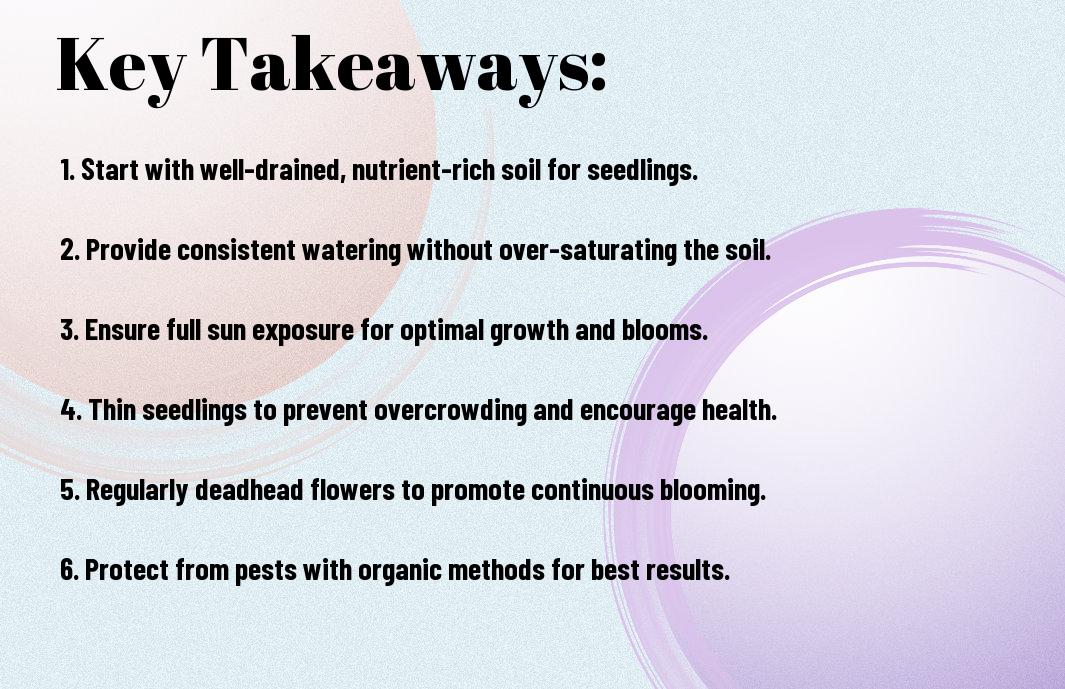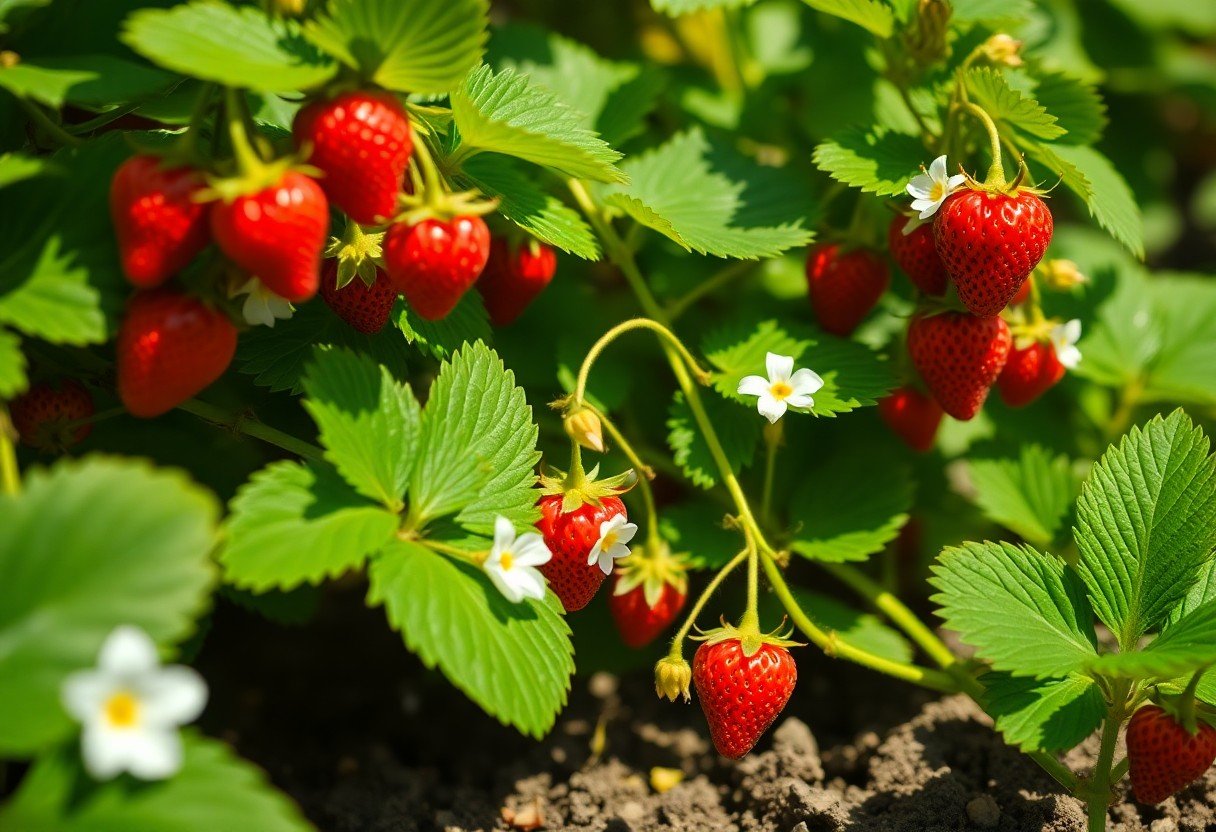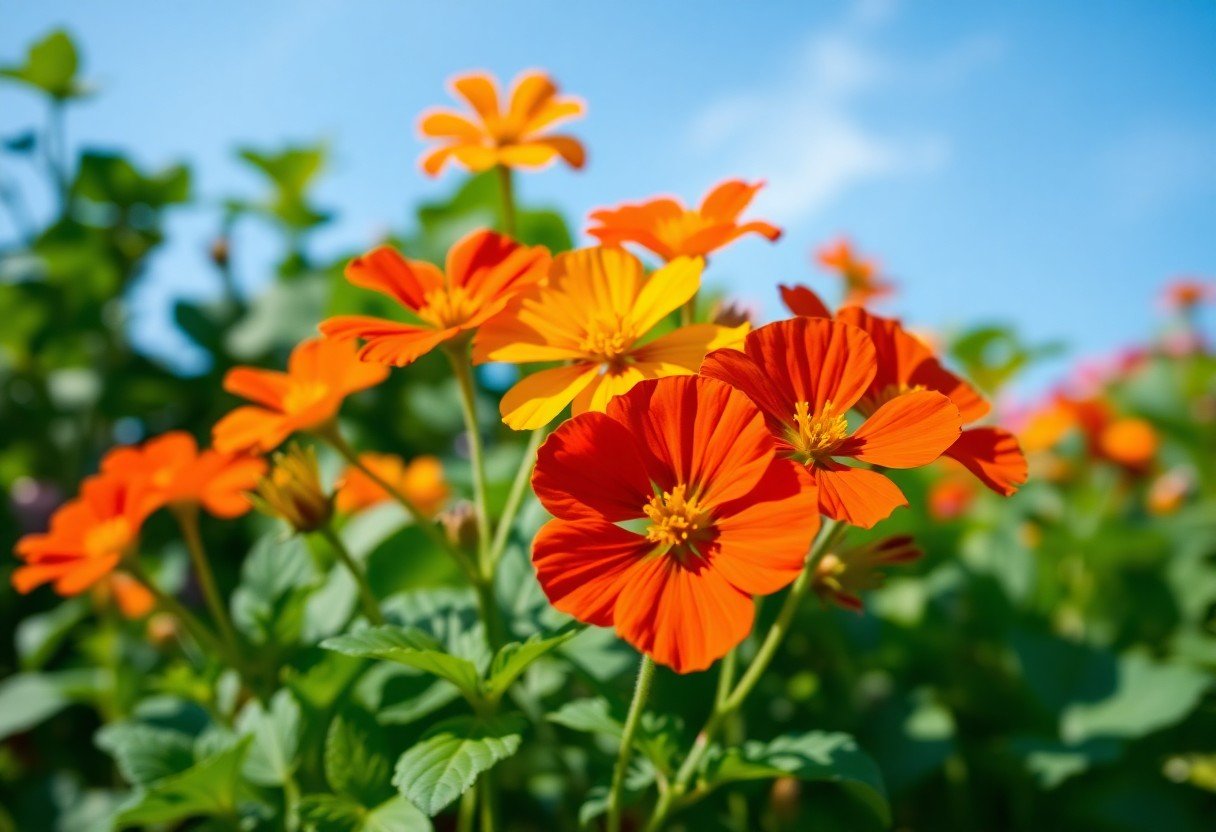With the right care, you can transform your garden into a stunning display of cornflowers, known for their vibrant sky-blue blooms. These delightful flowers not only add charm but are also relatively easy to cultivate, whether you’re a seasoned gardener or a beginner. From planting delicate seedlings to nurturing their growth, this guide will provide you with crucial tips to ensure your cornflowers thrive and grace your outdoor space with their beauty throughout the growing season.
Key Takeaways:
- Cornflowers require meticulous care during their early growth stages, including proper soil preparation and adequate watering to ensure healthy development.
- Consistent maintenance, such as deadheading spent blooms and monitoring for pests, contributes to a flourishing display of vibrant blue flowers throughout the growing season.
- Cornflowers thrive in full sun and well-draining soil, making them an ideal choice for garden borders and wildflower meadows.

Understanding Cornflowers
The cornflower, known scientifically as Centaurea cyanus, is a stunning floral gem that adds a pop of color to any garden. Originating in Europe, these charming blooms can be found in a variety of colors, with the classic sky-blue variety capturing the hearts of many gardeners. They thrive in well-drained soil and are commonly utilized for both ornamental and practical purposes, attracting pollinators while featuring prominently in floristry.
Overview of Cornflower Varieties
Behind the classic blue variety, cornflowers come in a range of colors including white, pink, and deep purple. Each variety boasts distinct characteristics and growth habits, allowing you to mix and match them to create a diverse and vibrant garden display. With some varieties reaching up to three feet tall, and others remaining more compact, there is certainly a cornflower that will suit your space.
Historical Significance and Cultural Importance
Around the world, cornflowers have deep historical roots and cultural significance. Traditionally, they have been used in various ceremonies and are often associated with love and loyalty. In Germany, for instance, these blooms are a symbol of devotion and are often featured in weddings. Their striking appearance has earned them a special place in art and literature, showcasing their lasting impact on society.
Due to their rich history, cornflowers have transcended generations and cultures. These flowers were once prized in ancient Greek and Roman times, believed to bring good luck and protection. They have also been cherished by poets and artists who admired their beauty. Today, cornflowers serve not only as a delightful addition to gardens but as a reminder of the deep connections humans have with nature throughout history. Cultivating cornflowers allows you not only to enjoy their beauty but also to become a part of their storied legacy.
Preparing for Planting
Any successful gardening endeavor begins with careful preparation. When growing cornflowers, this means ensuring you select the right location, prepare the soil properly, and understand the optimal planting times and conditions to nurture your seedlings into thriving plants.
Choosing the Right Location
With a preference for full sun, cornflowers thrive best in locations that receive at least 6 to 8 hours of direct sunlight each day. Look for areas with good air circulation to help prevent disease while ensuring your plants have the right exposure to light for optimal growth.
Soil Requirements and Preparation
Requirements for cornflower cultivation include well-draining soil rich in organic matter. Aim for a soil pH between 6.0 and 7.0 for the best results.
Consequently, you should amend your soil with compost or well-rotted manure to enhance its fertility before planting. Tilling the soil to a depth of about 12 inches will also help improve drainage and aeration, creating a healthy environment for your cornflower roots to establish themselves.
Optimal Planting Time and Conditions
Across various regions, cornflowers can be planted in early spring or early fall, depending on your climate. Ideally, you’ll want to wait until the threat of frost has passed for spring planting. Aim for soil temperatures of at least 65°F for optimal germination rates.
Optimal planting conditions involve ensuring your soil is moist but not waterlogged, as overly wet conditions can hinder seedling growth. When planting, a spacing of 12 to 18 inches between each seedling will promote healthy growth and flowering, allowing each plant to thrive in the garden.

Planting Cornflowers
After selecting your cornflower seeds or transplants, it’s time to prepare for planting. Not only does choosing the right planting method influence growth, but it also shapes the overall health of your cornflowers. Whether you opt for seeds or transplants, following proper procedures will set the foundation for a vibrant display of blue blooms in your garden.
Propagation Techniques: Seeds vs. Transplants
By deciding to propagate cornflowers through seeds or transplants, you can tailor your gardening approach to your preferences. Seeds allow for a greater variety selection and a more natural growing experience, while transplants can provide a head start, enabling earlier blooms. Assess your gardening conditions and choose the method that best aligns with your goals.
Sowing Seeds: Methods and Depth
Methods for sowing cornflower seeds include both direct sowing in the garden or starting them indoors. When sowing directly, aim to plant seeds approximately 1/4 inch deep into the soil. For indoor setups, sprinkle the seeds on the surface and gently cover with a thin layer of soil, keeping them moist until germination.
At this stage, you’ll want to ensure that the soil is well-prepared and free of debris or weeds. Lightly firm the soil after sowing to create good seed-to-soil contact, which is crucial for effective germination. Keep your seeds hydrated during the germination period, and sunlight will further assist in promoting healthy growth.
Spacing Considerations for Healthy Growth
Beside understanding planting depth, spacing your cornflowers appropriately is vital for their development. Aim for 10 to 12 inches between plants to allow proper air circulation and minimize the risk of disease. This spacing also enables each flower to have enough room to flourish and reach its full height.
Depth and spacing work hand-in-hand in fostering a healthy garden. By allowing adequate space, you provide each cornflower ample access to nutrients and sunlight. This not only contributes to their robust growth but also enhances the overall aesthetic appeal of your garden, resulting in a stunning display of sky-blue flowers. With the right attention to these details, your cornflowers will thrive beautifully!

Care and Maintenance
All plants require attention, and cornflowers are no exception. Proper care and maintenance can ensure that your cornflowers flourish, providing vibrant colors for your garden. From watering to fertilizing and pruning, each aspect plays a significant role in supporting their growth and beauty.
Watering Techniques and Schedules
One effective way to water your cornflowers is to provide them with deep, infrequent watering to encourage strong root growth. Aim to water them early in the morning or late in the evening, allowing the soil to absorb moisture without the harsh heat of midday sun. Monitor soil moisture and only water when the upper inch feels dry to the touch.
Fertilization Guidelines for Robust Growth
An ideal way to promote healthy cornflower growth is through careful fertilization. Use a balanced, slow-release fertilizer at the beginning of the growing season to give your plants the nutrients they need. You may opt for organic options like compost or well-rotted manure to enrich the soil naturally.
Considering your fertilization approach is vital for maintaining robust cornflowers. A light application of fertilizer every month during the growing season can support budding and blooming. Be cautious not to over-fertilize, as this can lead to excessive foliage growth at the expense of flowers.
Pruning and Deadheading for Continuous Blooms
Among the tasks that promote continuous blooming in cornflowers, regular deadheading is important. Remove spent blooms promptly to encourage your plants to produce more flowers and prevent them from going to seed too early. This not only enhances the aesthetic appeal of your garden but also prolongs the blooming period of your cornflowers.
Continuous deadheading will stimulate new growth, enhancing the overall health of your cornflower plants. As you prune back faded flowers, you allow for more energy to be directed towards new blossoms, ensuring your garden remains vibrant throughout the season.

Pest and Disease Management
Unlike some garden flowers, cornflowers can fall prey to a variety of pests and diseases. Effective management of these issues is vital to maintain the health and beauty of your plants.
Common Pests Affecting Cornflowers
With your cornflowers, you may encounter common pests such as aphids, spider mites, and caterpillars. These pests not only damage the foliage but can also lead to stunted growth and decreased flowering. Regularly inspecting your plants for signs of infestation will help you take timely action.
Recognizing and Treating Fungal Diseases
After planting cornflowers, it’s important to monitor them for fungal diseases such as powdery mildew or rust. These diseases can appear as white, powdery spots on leaves or orange, rust-colored pustules, respectively. Identifying these symptoms early can be vital for the health of your flowers.
Disease can spread quickly among cornflower plants, especially in humid conditions. To treat fungal infections, you can remove the affected leaves and improve air circulation around your plants. Using fungicidal sprays as a preventative measure can also be effective in minimizing damage.
Natural Remedies and Prevention Strategies
Pests can be deterred using natural remedies such as neem oil, insecticidal soap, or introducing beneficial insects like ladybugs. Employing these methods can help ensure the vitality of your cornflowers without resorting to harsh chemicals.
Hence, integrating companion planting and maintaining healthy soil will strengthen your cornflowers against pests and diseases. Regularly rotating your crops and ensuring proper spacing can also help prevent infestations. By staying proactive, you can cultivate a flourishing garden of stunning cornflowers.
Harvesting Cornflowers
For those growing cornflowers, harvesting is a rewarding process that allows you to enjoy the full beauty of your labor. Timing and technique are key in acquiring the best blooms for various uses, whether it be for bouquets, dried arrangements, or culinary purposes.
When to Harvest for Optimal Quality
Before you cut your cornflowers, wait until they are fully open but not yet beginning to wilt. The ideal time to harvest is in the morning after the dew has dried, as this yields the freshest blooms. Aim for peak blossom periods for maximum color and fragrance.
Techniques for Cutting and Handling Flowers
Beside choosing the right time, proper cutting and handling techniques will extend the life of your cornflowers. Use sharp shears to make a clean cut at an angle, which helps the stems absorb water better. Handle the flowers gently to prevent bruising or damaging the delicate petals.
Even if cornflowers are hardy, their delicate nature requires careful handling. After cutting, place the cornflowers immediately in water to maintain hydration and prevent wilting. If you’re not arranging them right away, store them in a cool, shaded area to preserve their freshness until you’re ready to use them.
Preserving Cornflowers for Dried Arrangements
By drying cornflowers, you can enjoy their beautiful hues long after the growing season has ended. Harvest them at their peak, and hang them upside down in a cool, dark place to allow them to dry naturally, preserving both color and shape.
Another effective method is to use silica gel for drying, which will help retain the cornflowers’ vibrant color. Simply place the flowers in a container filled with silica gel, covering them completely. This method not only speeds up the drying process but also keeps your blooms looking fresh and beautiful for your dried arrangements.
Conclusion
Hence, nurturing your cornflower from delicate seedlings to their stunning sky-blue blooms requires attention and care. By providing optimal soil, consistent watering, and the right amount of sunlight, you can enjoy a flourishing garden filled with these beautiful flowers. With a little effort, you’ll cultivate not only a visual delight but also a thriving ecosystem in your outdoor space. Embrace the journey, and soon you will be rewarded with the vibrant beauty of cornflowers gracing your garden.
FAQ
Q: What are the ideal growing conditions for cornflowers?
A: Cornflowers thrive best in well-draining soil that is moderately fertile. They prefer full sun but can tolerate partial shade. When planting, ensure the soil temperature is above 60°F (16°C) for optimal germination. These flowers are drought-resistant once established, making them suitable for various climates. Regular watering is advised during dry spells, particularly when they are still seedlings.
Q: How do I properly care for cornflower seedlings?
A: To care for cornflower seedlings, start by sowing seeds directly into prepared soil or in seed trays indoors a few weeks before the last frost. Once the seedlings have developed a couple of true leaves, gradually acclimate them to outdoor conditions through a process known as hardening off. When transplanting, space them about 12 inches apart to allow for proper air circulation. Keep the soil consistently moist, but avoid overwatering, which can lead to root rot.
Q: What pests and diseases should I watch out for with cornflowers?
A: Cornflowers are generally resistant to pests and diseases, but from time to time, you might encounter aphids or whiteflies. Using insecticidal soap or neem oil can effectively manage these pests. Additionally, ensure good air circulation around the plants to prevent fungal diseases such as powdery mildew. Proper spacing and avoiding overhead watering can help minimize the risk of such issues.










